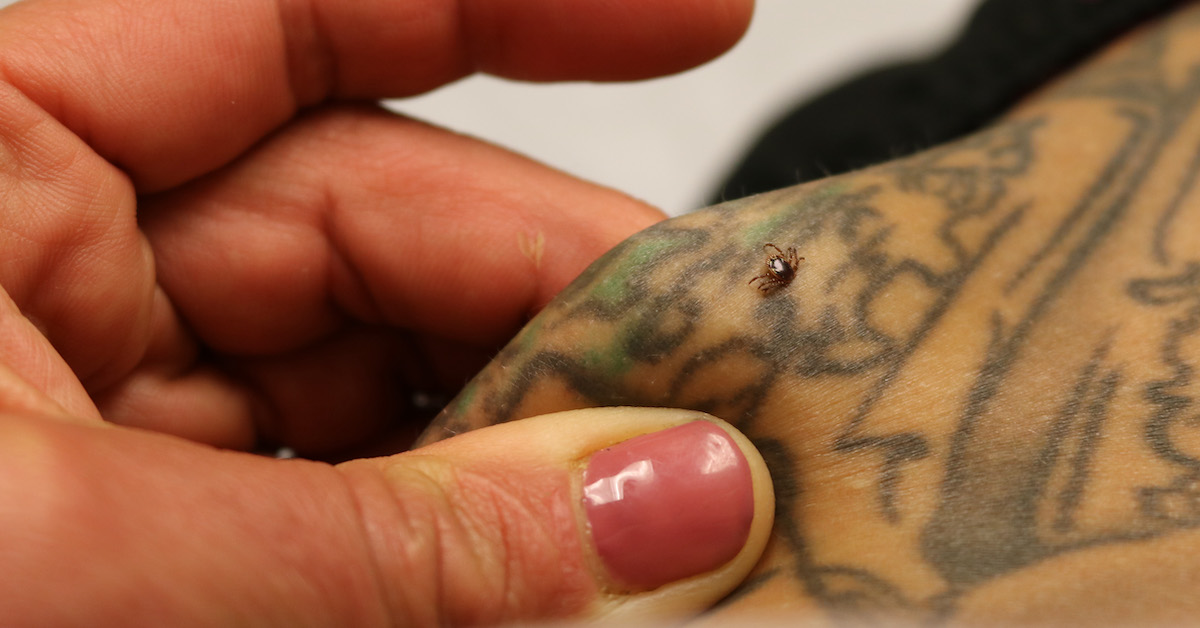on
How Much Should You Worry about That Bite?
Most people who spend time outdoors know they need to watch out for ticks. But there are a lot of misconceptions about the little buggers that need to be cleared up.
Today we’re setting the record straight. Here’s what you need to know about ticks—and how much you should really worry if you’re bitten.
Bitten by a Tick? Don’t Panic.

It’s rare that a tick bite will cause you harm, so don’t panic if you happen to pick one up.
For perspective, millions and millions of Americans are bitten by ticks every year. Of those, here are the number of cases that result in illness (according to the most recent counts of common, well-tracked diseases):
- Anaplasmosis: 4,008
- Babesiosis: 2,161
- Lyme Disease: Approximately 30,000
- Ehrlichiosis: 1,799
- Powassan Virus Disease: 39
- Rocky Mountain Spotted Fever: Approximately 5,500
- Tularemia: Approximately 100
What You Need to Know about Lyme Disease

The most well-known and common tick-borne illness in the US is the bacterial infection called Lyme Disease. Most of us know that Lyme Disease is a very serious illness that can cause severe complications that last years.
But did you know that most cases of Lyme Disease are cured after a single round of treatment? Only 10 to 20 percent of cases extend beyond that—these are called Chronic Lyme Disease, Post Lyme Disease Syndrome, or post-treatment Lyme Disease.
It’s still a mystery why some people develop Chronic Lyme Disease while others recover quickly. Those who suffer from the long-term version of the illness typically see symptom improvements in six months to a year.
The other thing to know is that your risk for Lyme Disease varies by region—this is the case for all the diseases transmitted by ticks. Currently, Lyme Disease is most common in the Upper Midwest, the Virginias, and the Northeast, with Pennsylvania by far reporting the most cases.
However, in some states, Lyme Disease is very rare. In 2019, for example, there were no reported cases of Lyme Disease in Oklahoma or Hawaii. Alaska reported only one, and Wyoming, Missouri, and Georgia reported two each.
How to Protect Yourself from All Types of Ticks
Having said all that, it’s a very good idea to take every possible precaution when going outdoors, especially in states and areas where tick-borne diseases are more common.
Here are some of the best steps to take to protect yourself and the people you love from ticks—all critical preparedness skills:
Avoid the tick habitats: Ticks tend to live in well-foliaged areas. High grasses, dense woods, and even piles of leaves in your yard are all prime breeding grounds for ticks. Stay out of these areas and keep your dogs and cats out of them, too. On outdoor adventures, choose clear campsites and stay in the center of trails when hiking.
Treat your clothing with tick repellent: The CDC lists the following substances as effective at keeping away ticks:
- Deet (in proper amounts)
- Picaridin
- IR3535
- Oil of Lemon Eucalyptus (OLE)
- Para-menthane-diol (PMD)
- 2-undecanone
Check out this search tool to find the repellent that’s right for you.
Dress to protect: Wear white, tan, and other light colors—this makes it easier to quickly spot any ticks that land on your clothing. Also, tuck your pant legs into your socks when you’re going outdoors.
Check your body for ticks: Ticks are miniscule—the tiniest varieties can be as small as a poppy seed. Check every part of your body for ticks, playing close attention to joints, hair, and behind your ears. It takes 36 hours for disease causing bacteria to get into your system. If you remove a tick before that, your chances of getting Lyme Disease are very low.
Shower right after getting home: This will wash off any ticks that haven’t attached yet. It will also give you a good chance to do a thorough body check.
Put your clothes in the dryer: Of course, you want to check your clothes as well as your body for ticks when you come indoors. But in case you miss any, just tumble dry your clothing for 10 minutes. That’s enough time to good-and-kill any ticks you carried in with you.
Practice proper tick removal: Removing a tick can be a little tricky depending on their size and where they’re lodged in your body, but regardless, proper technique is critical.
According to the CDC:
- Use fine-tipped tweezers to grasp the tick as close to the skin’s surface as possible.
- Pull upward with steady, even pressure. Don’t twist or jerk the tick; this can cause the mouth-parts to break off and remain in the skin. If this happens, remove the mouth-parts with tweezers. If you are unable to remove the mouth easily with clean tweezers, leave it alone and let the skin heal.
- After removing the tick, thoroughly clean the bite area and your hands with rubbing alcohol or soap and water.
- Never crush a tick with your fingers. Dispose of a live tick by putting it in alcohol, placing it in a sealed bag/container, wrapping it tightly in tape, or flushing it down the toilet.
(You may also want to save the tick for later identification.)
When to See a Doctor
As we’ve said, most tick bites result in nothing but a quick scare. However, in any of the following circumstances, please visit a doctor:
- A tick you can’t remove is lodged in your skin
- You develop a circular rash
- The area of the bite begins to infect
- You develop flu-like symptoms
- You have reason to believe you’ve been bitten by a deer tick
Get access to premium content and more!






